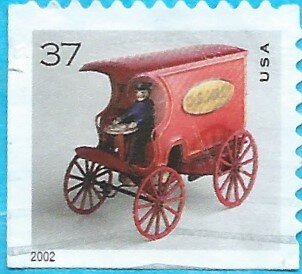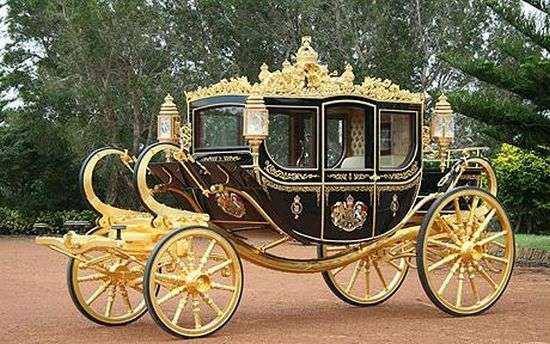Stamp: Toy Mail Wagon (United States of America 2002)
Toy Mail Wagon (United States of America 2002)
26 July (United States of America ) within release Toy Vehicles goes into circulation Stamp Toy Mail Wagon face value 37 United States cent
| Stamp Toy Mail Wagon in catalogues | |
|---|---|
| Michel: | Mi: US 3619IBDlu |
Stamp is horizontal format.
Filigrane:sans filigrane Pointage:33% Pertinence: Faible Description:Imperforated lef and bottom Date 2002Also in the issue Toy Vehicles:
- Stamp - Toy Locomotive face value 37;
- Stamp - Toy Mail Wagon face value 37;
- Stamp - Toy Fire Pumper face value 37;
- Stamp - Toy Taxicab face value 37;
- Se-tenant - Toy Vehicles face value 4*37;
- Stamp - Toy Mail Wagon face value 37;
- Stamp - Toy Locomotive face value 37;
- Stamp - Toy Taxicab face value 37;
- Stamp - Toy Fire Pumper face value 37;
- Se-tenant - Toy Vehicles face value 4*37;
- Se-tenant - Toy Vehicles face value 4*37;
- Se-tenant - Toy Vehicles face value 6*37;
- Se-tenant - Toy Vehicles face value 6*37;
- Booklet - Toy Vehicles face value 16*37;
- Stamp - Toy Taxicab face value 37;
- Stamp - Toy Locomotive face value 37;
- Stamp - Toy Fire Pumper face value 37;
- Stamp - Toy Taxicab face value 37;
- Stamp - Toy Mail Wagon face value 37;
- Stamp - Toy Mail Wagon - First Class face value 37;
- Stamp - Toy Fire Pumper face value 37;
- Booklet - Antique Toys 37c Vending Booklet face value 7.40;
- Stamp - Toy Taxicab face value 37;
- Stamp - Toy Mail Wagon face value 37;
- Stamp - Toy Fire Pumper face value FIRST;
- Stamp - Toy Fire Pumper face value 37;
- Stamp - Toy Locomotive face value 37;
- Stamp - Toy Mail Wagon face value 37;
- Stamp - Toy Locomotive face value 37;
- Booklet - Antique Toys First Class Vending Booklet face value 20*First;
- Stamp - Toy Locomotive face value 37;
- Stamp - Toy Fire Pumper face value 27;
- Stamp - Toy Taxicab face value 37;
Stamp Toy Mail Wagon it reflects the thematic directions:
A carriage is a two- or four-wheeled horse-drawn vehicle for passengers. Second-hand private carriages were common public transport, the equivalent of modern cars used as taxis. Carriage suspensions are by leather strapping or, on those made in recent centuries, steel springs. Two-wheeled carriages are usually owner-driven.
A car is a wheeled, self-powered motor vehicle used for transportation and a product of the automotive industry. Most definitions of the term specify that cars are designed to run primarily on roads, to have seating for one to eight people, to typically have four wheels with tyres, and to be constructed principally for the transport of people rather than goods. The year 1886 is regarded as the birth year of the modern car. In that year, German inventor Karl Benz built the Benz Patent-Motorwagen. Cars did not become widely available until the early 20th century. One of the first cars that was accessible to the masses was the 1908 Model T, an American car manufactured by the Ford Motor Company. Cars were rapidly adopted in the United States of America, where they replaced animal-drawn carriages and carts, but took much longer to be accepted in Western Europe and other parts of the world.
A toy or plaything is an object that is used primarily to provide entertainment. Simple examples include toy blocks, board games, and dolls. Toys are often designed for use by children, although many are designed specifically for adults and pets. Toys can provide utilitarian benefits, including physical exercise, cultural awareness, or academic education. Additionally, utilitarian objects, especially those which are no longer needed for their original purpose, can be used as toys. Examples include children building a fort with empty cereal boxes and tissue paper spools, or a toddler playing with a broken TV remote control. The term "toy" can also be used to refer to utilitarian objects purchased for enjoyment rather than need, or for expensive necessities for which a large fraction of the cost represents its ability to provide enjoyment to the owner, such as luxury cars, high-end motorcycles, gaming computers, and flagship smartphones.



